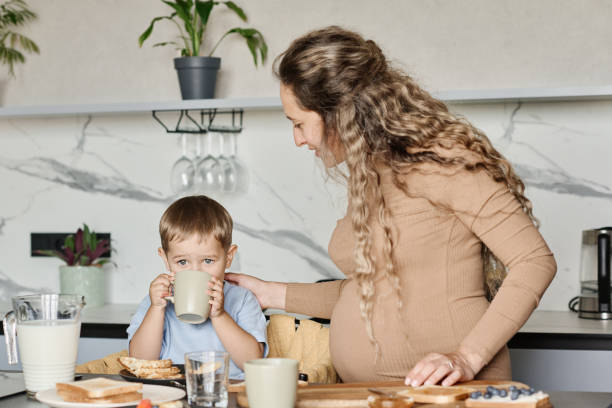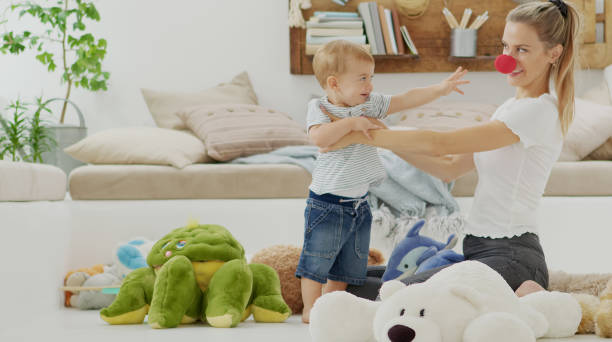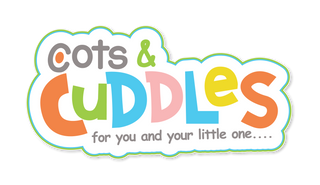Introduction:
Welcome to our blog dedicated to parents and primary caregivers of children just steeping in school. Mornings can often feel like a whirlwind of chaos, especially when you have a little one in the house. From getting dressed and eating breakfast to packing bags and saying goodbye, the morning routine can quickly become a source of stress and frustration. And if you're navigating the additional challenge of your child starting daycare or preschool, the stakes can feel even higher. But fear not! In this edition of our blog, we're here to provide you with valuable tips and insights to transform your morning routine madness into a smooth and stress-free experience. We understand that establishing a positive morning routine is crucial not only for your child's well-being but also for your own sanity. By implementing effective strategies and nurturing a sense of structure, independence, and responsibility, you can set the tone for a successful day ahead.
This blog is specifically designed to address the unique needs of children aged 2 to 3 years, a period characterized by rapid growth, increasing independence, and emerging self-awareness. We'll guide you through the challenges that come with transitions, such as starting daycare or preschool, and offer practical advice to navigate these changes seamlessly. Throughout the sections of this blog, we'll cover a wide range of topics to equip you with the tools necessary for a smoother morning routine. From understanding the importance of routines during transitions to planning ahead for success, engaging your child effectively, managing transitions and meltdowns, and even practicing self-care for yourself, we've got you covered.

We believe that a well-planned and executed morning routine not only benefits your child but also sets a positive tone for the rest of the day. By following our tips and implementing the suggested strategies, you'll not only witness a calmer start to your mornings but also foster your child's development, independence, and emotional well-being. So, get ready to transform your mornings from chaos to calmness as we embark on this journey together. Let's dive into the various sections, each filled with insights and practical advice, to help you navigate the morning routine madness and ensure stress-free mornings for both you and your child.
Transitioning to a New Routine
By addressing these aspects of transitioning to a new routine, you can help your child navigate the changes with greater ease and minimize stress and anxiety associated with starting daycare or preschool.
1.1 Understanding the importance of routines during transitions
Transitions, such as starting daycare or preschool, can be overwhelming for young children. Establishing and maintaining consistent routines during these times can provide them with a sense of stability and security. This section delves into the significance of routines during transitions and how they can positively impact your child's overall well-being.
1.2 Recognizing signs of anxiety and stress in your child
Transitions can evoke feelings of anxiety and stress in children. As a primary caregiver, it's essential to be aware of the signs that indicate your child may be experiencing these emotions. By understanding their cues, you can offer the necessary support and reassurance to help them adjust to their new routine smoothly.
1.3 Preparing your child for the upcoming changes
Preparing your child for a new routine involves gradual and age-appropriate explanations about what to expect. This sub-section provides practical strategies to communicate with your child, such as using visual aids, books, or role-playing, to help them understand and anticipate the changes ahead. By preparing them in advance, you can alleviate some of their anxieties and facilitate a smoother transition.
1.4 Establishing a consistent sleep schedule for a better morning routine
A well-rested child is more likely to have a positive start to the day. This sub-section focuses on the importance of a consistent sleep schedule and offers tips on creating a calming bedtime routine to ensure your child gets adequate sleep. By prioritizing healthy sleep habits, you can set the stage for a smoother morning routine, reducing stress for both you and your child.
Planning Ahead for Success

By focusing on these planning strategies, you can streamline your morning routine and create a more efficient and enjoyable experience for both you and your child. Remember, preparation is key to reducing stress and setting a positive tone for the day ahead.
2.1 Organizing the night before:
Preparing clothes, meals, and supplies
- Lay out clothes: Tips for choosing appropriate and weather-appropriate outfits
- Meal prep: Quick and nutritious breakfast ideas for busy mornings
- Packing essentials: Creating a checklist for daycare or preschool supplies
2.2 Creating a visual schedule to enhance understanding and independence
- The power of visuals: Why visual schedules work for young children
- Designing a visual schedule: Step-by-step guide and recommended resources
- Customizing the schedule: Incorporating your child's preferences and interests
2.3 Setting realistic expectations for morning tasks
- Identifying age-appropriate tasks: What your child can reasonably handle
- Breaking down tasks: Chunking activities into manageable steps
- Time management tips: Allocating sufficient time for each task
2.4 Incorporating small, enjoyable activities to motivate your child
- Morning playtime: Engaging your child in fun and stimulating activities
- Music and movement: Incorporating music and dance to energize and uplift
- Special rewards and incentives: Creative ideas to encourage cooperation
Strategies for Engaging Your Child
Remember, the goal is to create a positive and engaging morning routine that empowers your child and fosters their independence. By incorporating these strategies, you can make the morning experience enjoyable for both you and your little one. Engaging your child during the morning routine is crucial for maintaining their interest and cooperation. Here are some strategies to make the process more enjoyable and interactive:
3.1 Fun and Interactive Wake-Up Routines to Start the Day Positively
- Incorporate playful elements into waking up your child, such as singing a cheerful morning song or engaging in a gentle tickle session.
- Use positive and enthusiastic language to create excitement and anticipation for the day ahead.
- Offer hugs, cuddles, and words of affirmation to help your child transition from sleep to wakefulness.
3.2 Encouraging Independence: Allowing Your Child to Make Choices
- Offer age-appropriate choices in the morning routine, such as selecting between two breakfast options or picking out a favorite outfit.
- Give your child a sense of ownership by involving them in small tasks, like pouring cereal into a bowl or setting the table.
- Celebrate their independence and praise their efforts to boost their confidence and motivation.
3.3 Making Hygiene Routines Enjoyable Through Games and Songs
- Turn teeth brushing into a game by using a timer or singing a special toothbrushing song.
- Use colorful and child-friendly toothbrushes, toothpaste, and other hygiene products to make the experience more engaging.
- Explore interactive bath toys or storytelling during bath time to keep your child entertained and interested.
3.4 Engaging Your Child in Age-Appropriate Tasks Like Dressing or Teeth Brushing
- Break down tasks into small, manageable steps and provide clear instructions to avoid overwhelming your child.
- Use visual cues, such as picture charts or sequence cards, to help your child understand and follow the steps independently.
- Offer gentle guidance and support when needed, and allow your child to complete tasks at their own pace.
Managing Transitions and Meltdowns

4.1 Smooth transitions between activities with gentle reminders
Smooth transitions play a crucial role in maintaining a stress-free morning routine. By providing gentle reminders and incorporating visual cues, you can help your child navigate from one activity to another smoothly. Here are some effective strategies:
-
Visual Timers: Use visual timers or countdown clocks to signal the end of one activity and the beginning of another. This visual representation helps your child understand the concept of time and prepares them for upcoming transitions.
-
Transition Songs or Rhymes: Create catchy transition songs or rhymes that you can sing together during transitions. This not only adds an element of fun but also acts as a cue for your child to move on to the next activity.
-
Transition Objects: Introduce a special object, such as a small toy or a picture, that your child can carry with them during transitions. This object provides comfort and familiarity, making the transition easier.
4.2 Strategies for handling separation anxiety during drop-off
Starting daycare or preschool can trigger separation anxiety in young children. Here are some helpful strategies to manage this anxiety during drop-off:
-
Establish a Familiar Routine: Create a consistent drop-off routine that includes a special goodbye ritual. This can be a hug, a kiss, or a secret handshake that provides comfort and reassurance to your child.
-
Brief and Positive Goodbyes: Keep your goodbyes brief and positive. Assure your child that you will return and reinforce the trust that you will always come back for them. Avoid lingering or showing signs of hesitation, as this can increase their anxiety.
-
Communication with Caregivers: Maintain open lines of communication with the daycare or preschool staff. Share any specific concerns or strategies that work for your child. The caregivers can provide extra support and comfort during the transition period.
4.3 Dealing with morning meltdowns:
Calming techniques and redirection Morning meltdowns can disrupt the flow of your routine. Here are effective strategies to help calm your child during these challenging moments:
-
Validate Emotions: Acknowledge your child's feelings and empathize with them. Let them know that it's okay to feel upset or frustrated. Use simple and age-appropriate language to help them understand their emotions.
-
Deep Breathing and Relaxation: Teach your child deep breathing techniques to help them self-regulate during meltdowns. Encourage them to take deep breaths in and out, counting together to promote a sense of calmness.
-
Redirect Attention: Engage your child in a different activity or redirect their attention to something positive. Offer a favorite toy, start a conversation, or initiate a game to divert their focus from the meltdown.
4.4 Building emotional resilience in your child through positive reinforcement:
Developing emotional resilience is crucial for children in managing stressful situations. Here are strategies to foster resilience and positive behavior:
-
Praise and Encouragement: Offer specific and genuine praise for your child's efforts and achievements. Recognize their small successes during the morning routine, such as getting dressed independently or completing a task without assistance. This reinforces their sense of accomplishment and boosts their confidence.
-
Problem-Solving Skills: Teach your child problem-solving skills by involving them in decision-making. Encourage them to brainstorm solutions to minor challenges they might encounter during the morning routine. This helps build resilience and a sense of control over their environment.
-
Emotional Support: Provide a safe and nurturing environment where your child feels comfortable expressing their emotions. Encourage open communication and offer comfort and reassurance during challenging moments. This helps them develop emotional resilience and coping mechanisms.
Practicing Self-Care for the Caregiver
5.1 Importance of Self-Care to Manage
Morning Stress Morning routines can be demanding, and as a primary caregiver, it's crucial to prioritize your own well-being. Taking care of yourself allows you to be more present, patient, and calm during the morning chaos. Remember that self-care is not selfish but essential for both you and your child. Here are some key points to consider:
- Recognize your needs: Identify what rejuvenates you and brings you joy. It could be as simple as enjoying a cup of tea, reading a book, or engaging in a brief meditation session.
- Time management: Allocate time for self-care by waking up a few minutes earlier or delegating certain tasks. Setting boundaries and making self-care a priority will help reduce morning stress.
- Physical well-being: Ensure you're getting adequate sleep, eating nutritious meals, and staying hydrated. Taking care of your physical health directly impacts your energy levels and ability to handle morning routines effectively.
5.2 Establishing Your Own Morning Routine for Personal Well-being
Designing a morning routine for yourself sets a positive example for your child and contributes to a smoother start to the day. Consider these suggestions:
- Morning rituals: Incorporate activities that bring you joy and set a positive tone for your day. This could include stretching, journaling, practicing gratitude, or listening to uplifting music.
- Mindfulness practice: Engage in mindfulness exercises such as deep breathing, meditation, or visualization to center yourself before the morning rush.
- Nourishing breakfast: Prioritize a nutritious breakfast to fuel your body and mind. Prepare simple, healthy meals in advance or explore quick options that suit your dietary preferences.
- Self-reflection: Take a moment to reflect on your intentions for the day. Consider setting positive affirmations or visualizing a successful and peaceful morning routine.
5.3 Seeking Support from Other Caregivers and Professionals
Remember, you're not alone in this journey. Seeking support from others can provide valuable insights, encouragement, and practical tips. Here's how you can connect with others:
- Parenting communities: Join local parenting groups or online communities where you can share experiences, ask for advice, and offer support to fellow caregivers.
- Connect with professionals: Reach out to early childhood educators, pediatricians, or parenting specialists for guidance specific to your child's developmental stage. They can provide valuable resources and strategies tailored to your needs.
- Build a support network: Establish relationships with other parents or caregivers who are going through similar experiences. Organize playdates, exchange ideas, and support each other during the transition phase.
5.4 Recognizing and Celebrating Small Victories Along the Way
Parenting is full of small wins, and celebrating them reinforces positive behavior and encourages both you and your child. Acknowledge and celebrate achievements, no matter how small, to create a positive and motivating environment. Here are some suggestions:
- Praise and encouragement: Offer specific and genuine praise to your child for completing tasks or displaying positive behavior during the morning routine. This boosts their confidence and strengthens their sense of accomplishment.
- Rewards and incentives: Consider introducing a reward system for consistent adherence to the morning routine. Use small incentives like stickers, a special treat, or extra playtime to recognize their efforts.
- Self-reflection: Take a moment at the end of each day to reflect on your own accomplishments and the progress you and your child have made. Remind yourself of the positive aspects of the morning routine and focus on the small victories.
Conclusion:
Navigating the morning routine madness with young children can be a challenging task, especially during significant transitions like starting daycare or preschool. However, armed with the right strategies and a positive mindset, you can transform chaotic mornings into smooth and stress-free experiences for both you and your child. By understanding the importance of routines during transitions, you can provide your child with a sense of stability and security. Recognizing signs of anxiety and stress in your child allows you to address their emotions effectively and support them through the changes ahead. Preparing your child for the upcoming transition by talking about it and involving them in the process can help ease their anxiety.

Planning ahead is key to a successful morning routine. By organizing clothes, meals, and supplies the night before, you can minimize the last-minute rush and ensure everything is ready to go. Creating a visual schedule empowers your child to understand and follow the routine independently. Setting realistic expectations for morning tasks and incorporating small, enjoyable activities can motivate your child and make the routine more engaging. Engaging your child during the morning routine is crucial for their participation and cooperation. Fun and interactive wake-up routines can set a positive tone for the day. Allowing your child to make choices and encouraging independence fosters their sense of autonomy. Making hygiene routines enjoyable through games and songs can turn potentially mundane tasks into enjoyable moments. Engaging your child in age-appropriate tasks like dressing or teeth brushing not only builds their skills but also promotes a sense of responsibility.
Transitions and meltdowns are inevitable, but there are strategies to manage them effectively. Smooth transitions between activities with gentle reminders help your child navigate the routine more smoothly. Strategies for handling separation anxiety during drop-off involve providing reassurance and establishing a goodbye ritual. Dealing with morning meltdowns requires patience, calming techniques, and redirection to help your child regain their composure. By offering positive reinforcement and building emotional resilience, you can support your child's emotional well-being throughout the morning routine. Remember, as a primary caregiver, self-care is essential. Prioritizing your own well-being and establishing your own morning routine can help you manage morning stress more effectively. Seek support from other caregivers and professionals who can provide guidance and assistance during this challenging time. Celebrate small victories along the way, recognizing the progress you and your child make in establishing a smooth and stress-free morning routine.
In conclusion, with patience, consistency, and love, you can overcome morning routine madness and create a positive and harmonious start to your child's day. By implementing the tips and strategies shared in this blog, you are setting the stage for your child's growth, development, and success during transitions. Stay tuned for more helpful parenting advice and resources tailored to your child's age and needs, and remember to embrace the joy and wonder of parenting every step of the way.

